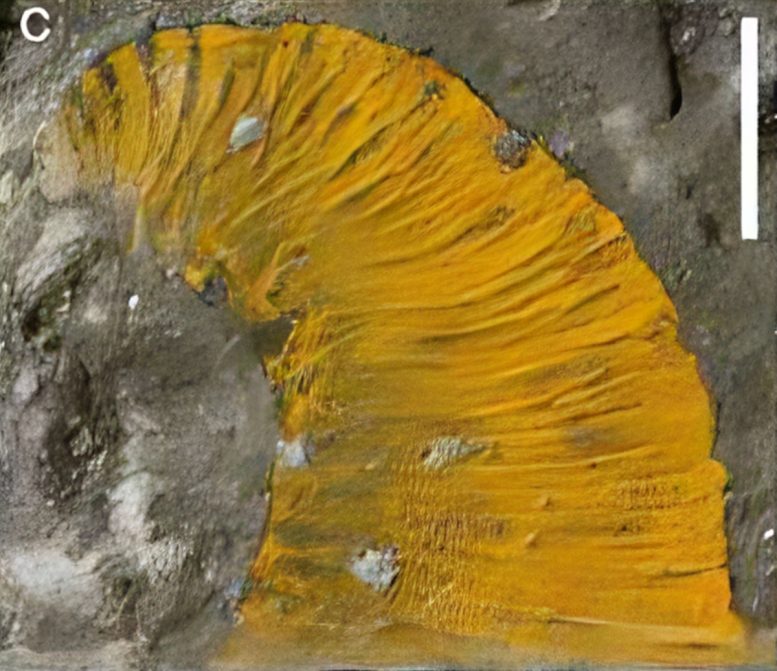
Holotype of Anguiscolex africanus. Credit: Complutense University of Madrid
A study led by the Complutense University of Madrid (UCM) and the Institute of Geoscience (IGEO, CSIC-UCM) has uncovered two well-preserved species of marine worms from the Palaeozoic era (Ordovician period) 455 million years ago at the Tafilalt Biota site in Morocco.
These worms correspond to the new genus and species Anguiscolex africanus, and the new species Wronascolex superstes.
Palaeoscolecid worms are not rare in the Paleozoic; the problem is that 99.99% of the fossil record comprises their sclerites (hard plates embedded in the cuticle) in isolation, which typically build up in certain limestone rocks. In other words, this type of worm lived in all the seas of the globe, but there is no evidence of their fossils other than at a tiny fraction of sites.
The worm fossils at the Moroccan site were articulated and well preserved in lutites (fine-grained rocks) and in an environmental context dominated by turbulent waters, which makes the finding, according to the UCM and IGEO paleontologist Juan Carlos Gutiérrez Marco, a “palaeontological surprise in a far from favorable geological context”.
The cuticle of these marine worms, described in Historical Biology, was covered in phosphatic microsclerites (measuring 20-100 thousandths of a millimeter), arranged in rings on the successive segments, their conservation being facilitated by rapid burying, having first been protected beneath bacterial veils which precipitated iron sulfides.
These two individuals are now added to the finding made some years ago, at the same site and by the same research team, of the worm Gamascolex vanroyi.
Worms that lived when Morocco was “polar”
Another of the conclusions highlighted by the study is the “gigantism” of the three worms known in the Tafilalt Biota, which are two to three times larger than the global record of palaeoscolecids in Australia, North America, and Central-Western Europe. “This circumstance could be connected with metabolic reasons involved in what is known as “polar gigantism”, as Morocco was very close to the Earth’s South Pole during the Ordovician Period,” Gutiérrez Marco explains.
This is the third of these organisms to be found in the Tafilalt Biota, an outstandingly well-preserved site containing a mixture of fossils from groups with hard parts (trilobites, mollusks, echinoderms) and others with a soft to weakly mineralized body (rare arthropods, worms, paropsonemid discs…).
The finding forms part of the ongoing research into the Ordovician in Morocco in connection with a series of projects under the National Plan (Ministry of Science and Innovation), with 15-day field seasons being organized in the desert terrain a couple of times a year.
The researchers also have a network of collaborators who locate fossils throughout the year and contact them if they find anything of note.
“We are trying to reconstruct the ecosystems and organisms of the past, and the data obtained help, in this case, to refine the geological correlation of the fossil-bearing units of Morocco with other contemporaneous units located on the marine shelf of the former continent of Gondwana”, the UCM researcher emphasizes.
Reference: “Polar gigantism and remarkable taxonomic longevity in new palaeoscolecid worms from the Late Ordovician Tafilalt Lagerstätte of Morocco” by Diego C. García-Bellido and Juan Carlos Gutiérrez-Marco, 29 October 2022, Historical Biology.
DOI: 10.1080/08912963.2022.2131404

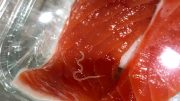
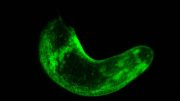
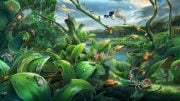
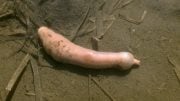

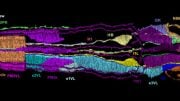

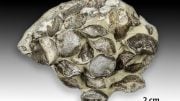
Be the first to comment on "Scientists Have Discovered the Remains of Two 455 Million-Year-Old Worms"